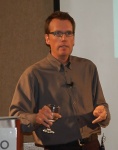Craig Sylverson (click to enlarge) |
Craig Syverson is giving a great talk on producing video for distribution on the 'Net. He breaks it down into a series of steps or concepts.
First, what's the concept? What are you trying to accomplish? What's the feeling and who's the audience. How will it be experienced? This is a question that really applies to 'Net distributed video. Will people see it on an iPod in an airplane or in their living room on an HDTV?
What's the strategy? How does it fit into the corporate strategy or what you're trying to do? Growth and scale is good to consider early. Video is resource intensive. If you succeed, will you be able to handle success? Video has unique qualities that differentiate it from print advertising or a documentary. With audio podcasts, program length isn't as big a problem. 'Net distribution has allowed video podcasts to be shorter than traditional video distribution outlets.
Repeat programs require format. Consistency reflect professionalism. The format should tie in with the concept.
Production is where the heavy lifting happens. Many people want to start with a camera, but you should start with a good writer. A good host is also a critical component. The format of the show can serve as a surrogate host. Watch the legal aspects. Remember that pictures are easy but sound is hard. If your sound is crap, it doesn't matter how good your video is.
Entry level HD cameras are a great place to start. Wireless lavaliere mics are a great way to get the mic close to the source. Pictures can be framed, but sound can't. Sony (UWP) and Sennheiser (Evolution) have released great prosumer kits. They come with crappy mics, so replaced them with Kung-Fu mics. On camera mics are generally a bad idea. He references Paul Figgiani's The Point podcast as a way to find out about good gear.
Post production requires a good editor--not necessarily the software, but the human. Post producing the audio is also needed to fix the sound in field situations. Overlay graphics get added here. Think of the screen. Remember backup. You're creating lots of data--back it up constantly.
Compressing is a dark art. It's very complicated. Video has different standards than audio. How many flavors will you offer to your audience? You have to continually experiment and test. ViddyUp is a good, cheap compression program with an unfortunate name.
Be consistent in how you name files, how you create ID tags, and how you put together the RSS feed. People will see these. Watch spaces, leading zeros in numbers, and how dates are formatted.
Of course, this all goes in an RSS file that needs to be hosted somewhere. Video uses a lot of bandwidth. He references Podcast Maker as a good application for doing all of this. He uses FeedBurner to get stats on downloads and have a consistent URL even if the hosting situation for his feed changes.
The same issues with Website design that Kris talked about for audio are true to video. Remember that a Web site is an archive for shows that are no longer in the RSS feed.
Stats are important. There's a lot of change happening with stats for podcasts. What constitutes a download, a listener, etc. Surveying your audience will help. Again, FeedBurner is important for stats. Podtrac is another.
Pay attention to promo materials. Get the bios, pictures, etc. in place. Design the artwork so that it looks good small, large, in color, and so on. PR Web is a cheap way to get press releases out.
Monetizing depends on the strategy. What's the value and to who?





